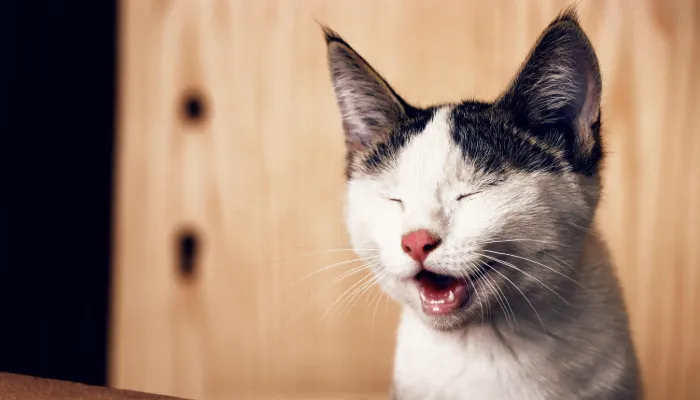Human to cat translator claims to simplify communication between humans and cats. These apps claim to interpret meows and produce sounds that humans can understand. Do these apps really work? The answer is not as straightforward as it seems. Understanding cats’ behavior and vocalization is a challenge in itself, as cats use a unique combination of body language, sounds, and actions.
Many apps have cat noises, but none have been proven to be accurate. In this article, we try to determine whether these apps indeed fulfill the purpose of helping the owners understand their cats or are just a source of fun. So let’s analyze these cat translator cat to human apps.

Human To Cat Translator: What is That?
Essentially, a human to cat translator is any application, game, or gadget that claims to translate human speech or human emotions into a form that a cat can understand. Often, these interpreters make presumptions based on the fact that cats do not solely speak through sounds but also use body language and scents. However, in order to qualify as a real human-to-cat translator, such a device would need to interpret these elements and “translate” them into something human ears could actually understand.
How Does It Work?
Most cat translator apps work based on concepts that are centered around translating a cat’s speech or analyzing its body movement using cameras to make sense of what the cat means. They know that it is difficult to determine a cat’s mood by just looking at its body. Some of the products claim that they are then using state-of-the-art AI to study the tone and frequency of the cat’s meows. Others are using traditional speech recognition paired with petting sensors to monitor the activity of the cat.
In simple words, the concept behind devising a Human to Cat Translator is observing factors such as the following:
- Vocalizations (meowing, purring and growling)
- Body Language (tail movements and ear position)
- Facial Expressions (eye shape and whisker movements)
- Context (feeding time, playtime and resting time)
Although it seems interesting, the reality is a bit more complicated. Like any other animal, cats have an intricate communication system that is associated with their instincts and environment.
As the theories of translating human speech to cat speech improve, there still exist numerous areas that require enhancement before being executed into practice.

Can a Human to Cat Translator Truly Work?
A Human to cat translator makes for an exhilarating prospect, but does it actually serve any purpose? Let’s break down the science and technology behind these devices.
Cat Vocalizations and Communication
Cats vocalize their feelings in multiple ways, using meows, purring, hisses as well as growls. Each of these communication tools has its specific correlation to an emotion that the cat is feeling, but the trick is in figuring out which emotion it is.
Purring has several meanings, with the most common relating to a content cat. But it can also be a show of great distress.
- Meowing: This is most common with cats while speaking to humans. Depending on the tone, inflection, and context, the cat can be saying anything from “I’m hungry” to “I want to cuddle,” or even “Pay attention to me.”
- Purring – Cats have purring as a component they generally do when in contentment but they also do it when in pain or frightened.
- Hissing and Growling – They absolutely display signs that articulate fear, aggression or discomfort.
Although specialized devices could be constructed to target the pitch, frequency, and tone of a cat’s voice, context would still play a crucial role and limit the devices’ effectiveness.
When it comes to comprehending vocal sounds from a cat, their context and meaning is so varied that no matter how developed we get, it is still an incredibly challenging task.
Non-verbal communication
The complexity of the task would also include an analysis of human body language communication with their feline companions as well. A Universal Human to Cat Translator would need to consider:
- Tail Position – Irrespective of how aggressive or unfriendly a cat’s nature could be, a raised tail in combination to walking signifies happiness while one that is tucked in is usually a sign of anxiety.
- Ear Position– Curiosity or interest is followed by ears erect towards the front but irritation and fear normally flattens them.
- Eye Contact – Slow blinking can be interpreted as affection and welcoming whilst pupils that are dilated signify excitement or maybe fear.
The difficulty of providing an accurate reading stems from the fact that one has to combine different signs, which makes the job of any cat translator cat to human rather tough.
Understanding cats encompasses considerable non-verbal communication, such as body language and facial expressions, but all of this can be very challenging for a machine to perceive.

Classification of Human to Cat Translators
Can they really transform humans into feline speakers? While true human to cat translators have yet to be made, a few devices exist which assist in humans communicating with their felines. Let’s examine the more popular products.
1. Cat Meow Translators
Cat translator cat to human devices and applications created to convert a feline’s meow into human speech have gained plenty of popularity. More than a few cat translator apps claim to translate cat meows into human language. These devices analyze and classify the frequency and tone of a meow. Different types of phrases include “Feed Me,” “Cuddle Up,” and, “Don’t”
Pros:
- User friendly
- A simple understanding of meows
Cons:
- Feline’s language has so much variation, that accuracy is not possible
- Does not take context and body language into account
2. AI Based Devices
AI-powered advanced devices have been created for more in-depth research. These devices interpret both the sound the cat makes, as well as its body language. These human to cat translator devices usually come equipped with sensors that pick up on a cat’s movements, posture, and interactions. Most believe these devices have figured out a way to meet all of a cat’s nuances and moods.
Pros:
- There is an opportunity for AI to improve with new inputs and data.
- Context-specific translations are provided (for instance, “Your cat is agitated because it’s near another animal”).
Cons:
- There is a lack of accuracy since the technology is still evolving in its use.
- For the average person, it’s costly.
3. Wearables and Collars
Advanced collars and wearables have sensors that record your cat’s heart rate, movements, and even sounds. These devices physically monitor your cat and feed the information through a designated smartphone app, which gives an overview of the cat’s health, mood, and needs adjustments. Some devices even integrate a human to cat translator, allowing pet owners to better understand their cat’s behavior and emotions based on the data collected.
Pros:
- Allows babysitting of the cat to be done hands-free.
- Could identify more serious health concerns (such as stress or anxiety) before they become too severe.
Cons:
- Often the procedures of “translation” rely too much on physical changes and not enough on behavioral emotions.
- It is not very accurate since cats can act very differently depending on the environment.
With the goal of improving communication between humans and cats these cat language translator devices and applications have been developed, however, there are still aspects that need improvement.
How Accurate Are Human to Cat Translators?
The human To cat translator app is still a work in progress. While some applications work well, others do not. The complicating factor is that cats do not talk in a structured way. Their sounds, actions, and movements can be deciphered in a million different ways depending on many aspects like:
- Character – Each cat sociably behaves singularly just as humans do.
- Setting – A cat’s mood fluctuates dramatically based on changes in one’s surroundings.
- Medical Conditions – Pain may modify a cat’s actions, making it difficult to assess.
For these reasons alone, it is understandable that not all cats can be translated successfully to humans. A cat translator cat to humans will probably miss capturing the nuances. A combination of devices and good old cat knowledge works best, although some of these devices do offer great perspective on one’s cat.
Such devices do offer helpful guidance, but they fall woefully short of being able to capture the intricate ways a cat communicates.
Alternatives to Using a Human to Cat Translator
In case you doubt the effectiveness of the human to cat translator, you can try other methods to connect with your cat better.
1. Learn Cat Body Language
If you observe the cat’s nonverbal cues and sounds, you can start to understand its feelings for you without using any sounds. For instance:
- If a cat is calm, meaning their tail and ears are relaxed. An anxious cat will have ears that are flattened and a tail that is twitching.
- The cat that is kneading or stretching on and around you can be showing care and affection.
2. Understand Their Routine
Cats are used to doing their activities within a fixed schedule and thus can be referred to as creatures of habit. You will be able to know their trends without getting a translator, as long as you can predict some of them during the day such as feeding times or periods when you play with them.
3. Pay Attention to Context
Cats often use context as a way of speech. A cat will meow around the slender belt while hopping without anything in the bowl. If a cat is purring while being stroked, his hands are all signs of the cat contentment.
Human to cat translator may not be the most valuable tool, knowing your cat’s unique behaviors and ways of communication can help a great deal.
Future of Human to Cat Translators
Humans tend to focus on human To cat translator and their further developments. For this, they have to fine-tune AI algorithms for better accuracy or improve methods of studying animal communication and finding more ways to connect between cats and humans. One day, we may have more advanced tools that can truly translate what is being said – not only through sounds but with manipulative and circumstantial signals as well.
Never forget, though, for now, we as humans have come to the realization that cats are very unpredictable. So, until then, we will continue to cherish cat companionship on how these gentle beasts approach our lives in the softest and most complex manners possible.
The future of turning human language to feline sounds is looking more probable than ever. There is still a lot of work to be done in making these devices dependable, though.
Human Interaction To Enhancing Cat Communication
Even though a human to cat translator can provide some insight, hands-on interaction is what truly elevates communication with your feline companion. Cats depend on relative trust, consistency, and sustainment from their owners which immensely helps in fostering a stronger bond that makes communication more effective.
- Trust Building through Consistency in Practice: Cats are considered to be partakers of habit and feel cozy in cycling sounds. Routine feeding, meal times, play times, and even affection enable them to feel comfortable seeking out their demands. Connecting these reinforcers, affection, or treats, further cements this bond when your cat behaves in a desirable manner.
- Identify Your Cat’s Distinct Personality: Every single cat is different at the core. Some cats are much more sociable and talkative while others are rather quiet and reserved. By recognizing these differences, it would be easier to improve your interaction with your cat easing the communication.
- Non-verbal cues: Changes in tail position or ear movement tell a lot about a cat’s feelings since cats rely on body language more than speech. Copying sensitive actions such as slow blinking is another way to enhance bonds.
- Enrichment Activities: Incorporating interactive play or training when it comes to your cat’s care can aid in their mental stimulation and enable better communication as in this case, your cat will be more open to seeking your attention.
Even with the help of technology, the best communication comes from the understanding and connection that you are able to foster.
Conclusion
To wrap up the human to cat translator, although it enhances the possibility of effortless communication with a cat, it is far from flawless. There will always be nuances to translation that require detailed attention to fully grasp a cat’s emotions and needs, which is why cat translators exist. They attempt to analyze vocalizations and body language, but often miss out on the deeper elements.
There are ways that might be more accurate and advanced as technology and research opportunities grow, but until that day comes, the best option to develop a bond with your cat is through keen observation and love. The concept of cat translator cat to human translator sounds stimulating, yet deeper attention to the subject still begs for research for a meaningful outcome.
Fostering a strong bond with your cat is still the most loving approach, even if it comes to the goal of developing an effective human to cat translator.
